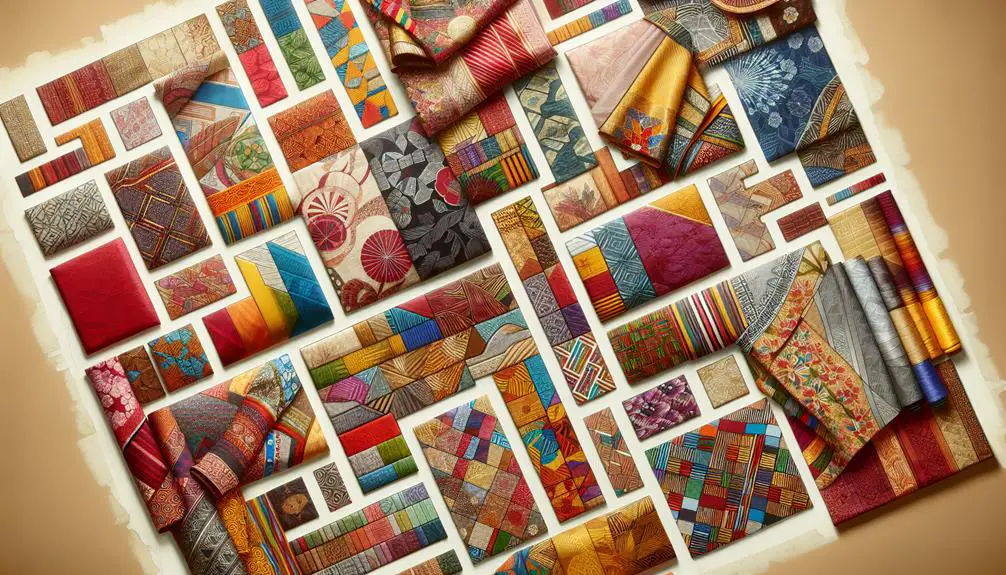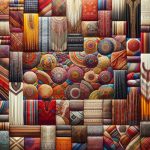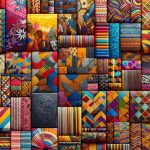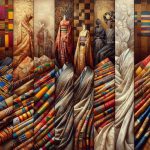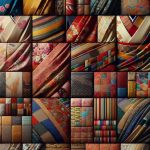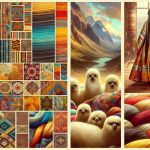You might think fabrics are just for fashion, but they carry deep cultural meanings across the globe. Consider the vibrant Kente cloth of Ghana, which isn't just colorful but signifies important life events. Or the elegant Japanese silk kimonos, embodying centuries of tradition and craftsmanship. Each textile tells a story, representing the identity and heritage of its people. By exploring these fabrics, you'll uncover a world where cloth isn't merely functional but a rich, cultural tapestry. Curious about what the Indian sari or Scottish tartan reveal about their cultures? Let's explore this fascinating topic further.
Table of Contents
Key Takeaways
- Fabrics often symbolize cultural heritage, identity, and social status, such as Nigerian Aso Oke and Mexican Rebozo shawls.
- Traditional textiles frequently mark significant life events, like Japanese silk kimonos for ceremonies and Ghanaian Kente cloth for important occasions.
- Intricate weaving and dyeing methods preserve centuries-old craftsmanship, evident in Indonesian Batik and Peruvian alpaca textiles.
- Patterns and motifs in textiles, such as Scottish tartan and Chinese silk brocade, represent historical, familial, and symbolic meanings.
- Sustainable and natural practices in fabric production, like Indian handloom saris and Moroccan Berber weaving, support local artisans and environmental conservation.
Kente Cloth of Ghana
When you think of traditional African textiles, the vibrant patterns of Kente cloth from Ghana likely come to mind. This iconic fabric, woven with meticulous Ghanaian craftsmanship, isn't just a visual spectacle; it's a tapestry of deep cultural symbolism.
Each pattern and color in Kente cloth tells a story, reflecting the history, philosophy, and social values of the Ashanti and Ewe people. Wearing Kente is often reserved for significant occasions, denoting status, celebrating achievements, or honoring heritage.
Mastering the traditional weaving methods requires skill and patience. Artisans use simple looms to interlace brightly colored threads in intricate patterns, a technique passed down through generations. This age-old process ensures that each piece of Kente is unique, embodying the weaver's expertise and creativity.
However, Kente cloth isn't confined to tradition alone. Modern adaptations have found their way into contemporary fashion and design, proving its timeless appeal. Designers around the world now incorporate Kente patterns into everything from haute couture to home decor, blending traditional aesthetics with modern sensibilities.
Japanese Silk Kimonos
Renowned for their elegance and intricate design, Japanese silk kimonos exemplify the pinnacle of traditional Japanese craftsmanship. When you explore the world of kimono craftsmanship, you'll uncover how artisans meticulously weave cultural symbolism into every thread. Each motif, from cherry blossoms to cranes, carries profound meaning, reflecting Japan's rich heritage and reverence for nature.
Silk production in Japan dates back over a thousand years, with the sericulture process being both an art and a science. The painstaking effort to cultivate silkworms and reel their delicate threads into luxurious fabric underscores the kimono's historical significance. As you investigate further, you'll discover that the choice of silk itself isn't merely for its lustrous beauty but also for its unparalleled durability and comfort.
Understanding the cultural symbolism embedded in kimonos enhances your appreciation of their historical significance. Worn during significant life events—such as weddings and tea ceremonies—kimonos are more than garments; they're heirlooms passed down through generations, each piece telling a story.
Mastering the nuances of Japanese silk kimonos allows you to grasp not only the technical prowess involved in their creation but also their role as living artifacts of Japan's cultural legacy.
Indian Sari Traditions
Much like the Japanese kimono, the Indian sari embodies centuries of cultural heritage and artistry. You'll find that sari draping techniques vary greatly across regions, showcasing the rich diversity of Indian culture. From the elegant Nivi drape of Andhra Pradesh to the bold Nauvari style of Maharashtra, each method tells a unique story.
| Region | Draping Technique | Distinct Features |
|---|---|---|
| Andhra Pradesh | Nivi | Pleated front, pallu draped over shoulder |
| Maharashtra | Nauvari | Dhoti-like drape, no petticoat needed |
| Gujarat | Gujarati | Pallu pulled over the right shoulder |
| Tamil Nadu | Madisar | Complex, worn for traditional events |
Modern sari trends have embraced these traditional techniques, blending them with contemporary styles to appeal to younger generations. You might notice saris with pre-stitched pleats or even saris paired with modern blouses, making them more accessible yet stylish.
In addition to these regional sari variations, sustainable sari practices are becoming increasingly popular. Opting for handloom fabrics and natural dyes not only supports local artisans but also reduces the environmental impact. By choosing eco-friendly options, you're participating in a movement that values both tradition and sustainability.
Scottish Tartan Patterns
When you think of Scottish tartan patterns, you might picture the unique designs tied to historical clans.
You'll find that the intricate weaving techniques create these iconic plaids.
Today, tartan isn't just for kilts; it's used in modern fashion and home decor too.
Historical Clan Associations
In the rich tapestry of Scottish history, tartan patterns have long served as a vibrant symbol of clan identity and heritage. Each pattern, or sett, represents a specific clan, encapsulating centuries of Scottish clan traditions and woven symbolism.
As you explore these designs, you'll discover that tartans are more than just colorful fabrics; they're visual representations of lineage, loyalty, and legacy. The meticulous arrangement of colors and lines tells a story unique to each clan, similar to how the intricate silk craftsmanship of Japanese kimono history embodies the cultural essence of Japan.
Understanding the historical clan associations with tartan patterns allows you to appreciate the depth of Scottish culture. Each clan's tartan was a badge of honor, worn during battles and significant ceremonies. The patterns were jealously guarded, passed down through generations, and used to distinguish allies from foes.
This practice mirrors the way specific kimono patterns were reserved for the Japanese aristocracy, symbolizing status and familial ties.
Tartan Weaving Techniques
Often, the intricate process of weaving tartan patterns requires skilled artisans who meticulously interlace threads to create these iconic designs. You'll find that mastering tartan weaving techniques involves understanding the tartan history deeply rooted in Scottish culture. Each traditional pattern tells a story, often linked to a specific clan or region, reflecting centuries of heritage and symbolism.
To achieve the precise designs, you need to learn the foundational weaving techniques. Start with the warp and weft threads, which are interlaced at right angles. The sequence of colors and the sett (the pattern's repeat length) are vital. Attention to detail ensures the resulting fabric mirrors the traditional patterns accurately.
The cultural significance of tartan is immense. Historically, these patterns weren't just decorative; they signified allegiance and identity. By mastering these weaving techniques, you're not only preserving a craft but also honoring the legacy of those who wore these patterns with pride.
Your journey into tartan weaving will demand patience and precision. With each weave, you're contributing to a rich tapestry of cultural significance that spans centuries. Embrace the challenge, and you'll find immense satisfaction in creating something both beautiful and meaningful.
Modern Tartan Applications
Today, tartan patterns extend beyond traditional garments, finding their way into contemporary fashion and home decor. You're now seeing tartan fashion in high-end collections, where designers embrace modern adaptations and innovative designs. These patterns aren't just for kilts anymore; they're making bold statements on runways and in everyday wear around the globe.
Incorporating tartan into your wardrobe allows for a blend of classic heritage and cutting-edge style. Modern adaptations see tartan on tailored suits, chic dresses, and even casual streetwear. The versatility of tartan patterns means you can effortlessly combine them with other global influences, creating unique and sophisticated looks.
But tartan's reach doesn't stop at fashion. In home decor, tartan fabrics add a timeless, yet contemporary touch to interiors. Think beyond the traditional Scottish cottage; innovative designs now incorporate tartan into upholstery, curtains, and even modern art pieces. Your home can achieve a balanced blend of warmth and elegance with these patterns.
Peruvian Alpaca Textiles
When you explore Peruvian alpaca textiles, you'll discover intricate traditional weaving techniques that have been passed down through generations.
These textiles are renowned for their vibrant patterns and colors, which reflect the rich cultural heritage of the Andean people.
You'll appreciate how each piece tells a story through its unique design and craftsmanship.
Traditional Weaving Techniques
Peruvian alpaca textiles showcase extraordinary craftsmanship, blending ancient weaving techniques with vibrant patterns. When you explore these traditional methods, you'll uncover a rich tapestry of cultural preservation and artistic expressions.
The weaving techniques, passed down through generations, serve as an essential link to the past, ensuring that the skills and stories of ancestors remain alive.
By engaging in these weaving practices, artisans foster strong community connections and deepen heritage appreciation. You'll find that the weavers often work together, sharing not just techniques but also a sense of identity and pride. This collaborative environment nurtures both individual creativity and collective wisdom, creating a dynamic cultural ecosystem.
Consider the following aspects to understand the intricacies of traditional Peruvian weaving techniques:
- Backstrap Looms: These portable looms allow weavers to create elaborate designs with remarkable precision.
- Natural Dyes: Artisans use locally sourced plants, minerals, and insects to produce a range of colors.
- Symbolic Patterns: Each pattern holds specific meanings, telling stories of the weaver's ancestry and environment.
- Time-Consuming Craft: Creating a single textile can take weeks or even months, reflecting the weaver's dedication and skill.
Vibrant Patterns and Colors
You'll be captivated by the alpaca textiles' vibrant patterns and colors, which reflect the rich cultural heritage of Peruvian artisans. Each piece is more than just visually striking; it embodies cultural symbolism that dates back centuries. The intricate designs often incorporate motifs from nature, local mythology, and historical events, adding layers of meaning to every textile.
When you wear or display these fabrics, you're not just enjoying their aesthetic appeal—you're also connecting with a deep cultural narrative.
Peruvian alpaca textiles have also made their mark on global fashion trends. Designers around the world are increasingly inspired by these vibrant patterns and rich colors, incorporating them into high-end fashion collections and everyday wear. This global resonance underscores the universal appeal of Peruvian artistry and craftsmanship.
By embracing these textiles, you're not merely following a trend; you're celebrating a timeless tradition that transcends borders.
Incorporating Peruvian alpaca textiles into your wardrobe or home decor allows you to appreciate their unique beauty while honoring the artisans who create them. You'll find that these pieces add a touch of cultural richness, transforming any setting into a tapestry of history and artistry.
Indonesian Batik Art
Indonesian Batik Art showcases a rich tradition of intricate patterns and vibrant colors that reflect the country's cultural heritage. You'll notice that this ancient craft is experiencing a Batik revival, with contemporary designs breathing new life into traditional motifs. Artisans are blending time-honored techniques with modern aesthetics, ensuring that Batik remains relevant and cherished.
The importance of cultural preservation through Batik can't be overstated. Each piece tells a story, often related to local folklore, religious beliefs, or historical events. Skilled artisans employ techniques that have been passed down through generations, using wax-resist dyeing methods to create stunning visual effects. This dedication to craft keeps the cultural essence alive.
Consider these fascinating aspects of Indonesian Batik:
- Historical Significance: Batik has been an integral part of Indonesian culture for centuries, often used in royal ceremonies and traditional attire.
- Artisan Communities: Entire communities specialize in Batik, fostering a sense of identity and pride among artisans.
- Global Influence: Batik has gained international recognition, influencing fashion designers worldwide.
- Sustainability: Many Batik producers emphasize eco-friendly practices, using natural dyes and sustainable materials.
Nigerian Aso Oke
You're about to explore Nigerian Aso Oke, a vibrant fabric that's integral to traditional Yoruba attire.
You'll learn how skilled artisans weave this cloth and discover its important role in ceremonies.
Let's uncover the beauty and significance of Aso Oke together.
Traditional Yoruba Attire
Have you ever marveled at the intricate patterns and vibrant colors of traditional Yoruba attire known as Aso Oke? This exquisite fabric is more than just clothing; it embodies the rich cultural heritage and identity of the Yoruba people. Aso Oke is often adorned with Yoruba beadwork, which holds ceremonial significance. These beads are meticulously crafted and often used to signify social status, spiritual beliefs, and important life events.
The Gele headwraps are another fascinating element of Yoruba attire. These elaborately tied headpieces aren't just fashion statements but symbols of cultural identity and pride. Wearing a Gele can transform an outfit, showcasing the wearer's skill and creativity.
When delving into traditional Yoruba attire, consider the following key aspects:
- Symbolism: Each pattern and color in Aso Oke carries specific meanings, often telling a story or conveying a message.
- Craftsmanship: The weaving process of Aso Oke is time-consuming and requires great skill, reflecting the artisans' dedication.
- Occasions: Aso Oke is commonly worn during weddings, festivals, and other significant events.
- Modern Influence: While deeply traditional, Aso Oke has also been embraced by contemporary fashion designers, bringing it to global attention.
Explore these layers, and you'll gain a deeper appreciation for the artistry and cultural depth of Yoruba attire.
Weaving Techniques Explained
Understanding the artistry behind Aso Oke starts with exploring the intricate weaving techniques that artisans employ to create this stunning fabric. You'll find that the heart of Aso Oke lies in its loom innovations and the meticulous processes involved in its creation. Artisans use traditional handlooms, which have evolved over centuries, to weave the fabric in narrow strips. This method not only preserves the cultural significance of the textile but also assures its unique texture and durability.
Natural dye techniques play a critical role in the fabric's vibrant colors. By employing indigenous plants and minerals, artisans achieve hues that are deeply embedded in Nigeria's textile traditions. The use of natural dyes guarantees that each piece carries a story, reflecting the landscape and heritage of the Yoruba people.
| Technique | Description |
|---|---|
| Handloom Weaving | Traditional handlooms create narrow strips, preserving texture and strength. |
| Natural Dyeing | Indigenous plants and minerals used for vibrant, lasting colors. |
| Pattern Creation | Complex designs woven directly into the fabric, showcasing craftsmanship. |
| Stitching | Strips are sewn together to form larger garments, maintaining cultural ties. |
Mastering these techniques allows you to appreciate the depth of skill and tradition that goes into every piece of Aso Oke, making it not just a fabric, but a living attestation to Nigerian heritage.
Ceremonial Uses Highlighted
Aso Oke holds a revered place in Nigerian ceremonies, symbolizing cultural heritage and marking significant life events. When you attend a wedding in Nigeria, you'll often notice the intricate Aso Oke fabric adorning the bridal attire. This isn't just about aesthetics; it's deeply rooted in cultural symbolism. The bride and groom wear Aso Oke to signify their union and respect for their heritage.
Moreover, Aso Oke transcends weddings. It plays a pivotal role in religious rituals, where its fabric significance is unquestionable. During traditional Yoruba festivals, you'll see community leaders donning this fabric, emphasizing its importance in spiritual and communal gatherings.
Consider these key aspects of Aso Oke's ceremonial uses:
- Weddings: The fabric is a staple in bridal attire, symbolizing unity and tradition.
- Naming Ceremonies: Families dress newborns in Aso Oke to welcome them into the community.
- Chieftaincy Titles: When individuals are conferred with titles, they wear Aso Oke to mark the honor.
- Religious Festivals: The fabric is donned to highlight its significance in spiritual practices.
Chinese Silk Brocade
Chinese silk brocade, renowned for its intricate patterns and luxurious feel, showcases the rich history and artistry of Chinese textile craftsmanship. You'll find that the cultural symbolism woven into each piece isn't just visually stunning but also deeply meaningful. These intricate designs often feature motifs like dragons, phoenixes, and peonies, each representing virtues such as power, grace, and prosperity.
| Cultural Symbolism | Intricate Designs |
|---|---|
| Dragons | Power |
| Phoenixes | Grace |
| Peonies | Prosperity |
| Clouds | Fortune |
| Bats | Happiness |
Historically, Chinese silk brocade was reserved for the elite, serving as a marker of social status and wealth. You can trace its origins back to the Han Dynasty, where it was used in imperial garments and palace decorations. Today, modern adaptations have brought this luxurious fabric into the contemporary fashion and interior design worlds, allowing a broader audience to appreciate its beauty and craftsmanship.
Moroccan Berber Weaving
Rooted in the rich traditions of the Berber people, Moroccan Berber weaving showcases vibrant patterns and meticulous craftsmanship. When you explore the world of Moroccan weaving techniques, you'll uncover a tapestry of cultural symbolism woven into every piece.
Each pattern tells a story, often reflecting the weaver's personal experiences and the community's collective history. Berber textile traditions date back centuries, with historical significance that's deeply interwoven with the identity of the Berber people. You'll find that these textiles are more than just practical items; they're treasured cultural artifacts.
The intricacy of the designs and the vibrant colors used in Moroccan Berber weaving highlight the weavers' skills and dedication.
- Symbolism: Patterns often represent fertility, protection, and natural elements, serving as talismans.
- Techniques: Traditional handloom weaving methods passed down through generations secure authenticity.
- Materials: Wool from local sheep, dyed with natural pigments, offers both durability and rich colors.
- Usage: Rugs, blankets, and clothing aren't only functional but also serve as artistic expressions.
Mexican Rebozo Shawls
Mexican rebozo shawls, famed for their vibrant colors and intricate patterns, are a proof of the country's rich textile heritage. When you explore the rebozo craftsmanship, you'll discover that each shawl is a tribute to the artisan techniques passed down through generations. These techniques involve a meticulous process of weaving, dyeing, and finishing, often by hand, making every rebozo a unique piece of art.
The cultural significance of rebozos can't be overstated. They serve as more than just accessories; they're symbols of identity, heritage, and social status. You'll find that these shawls are integral to various life events, from births to weddings to funerals. Their versatility is astounding—they can be used as baby carriers, head coverings, or even as a means of self-expression.
Understanding the historical evolution of the rebozo reveals its journey from pre-Hispanic times to the present. Originally influenced by indigenous weaving methods, the rebozo has adapted to include European techniques, resulting in a rich tapestry of cultural fusion. By appreciating the depth of rebozo craftsmanship, you're not just admiring a piece of fabric; you're engaging with a living history.
Frequently Asked Questions
What Are the Environmental Impacts of Traditional Fabric Production Methods?
You'll find traditional fabric production often negatively impacts the environment. These methods can lead to deforestation, water pollution, and high energy consumption. Addressing sustainability concerns means adopting eco-friendly practices and reducing harmful environmental impact.
How Has Globalization Influenced Traditional Fabric-Making Techniques?
Globalization's impact on fabric techniques has been profound. You see traditional fabrics incorporating diverse cultural influences, blending ancient methods with modern innovations. This fusion enhances craftsmanship, but it also risks diluting unique cultural identities.
Are There Any Modern Uses for Traditional Fabrics in Contemporary Fashion?
In today's steampunk-inspired fashion, you'll find traditional fabrics being utilized with sustainable innovation and fashion fusion. Designers are blending historical textiles with modern styles, creating unique, eco-friendly garments that honor heritage while pushing contemporary boundaries.
What Are the Ethical Considerations in the Production of Traditional Fabrics?
When considering traditional fabric production, you must focus on fair trade practices and sustainable sourcing. Guarantee artisans receive fair wages and that materials are responsibly sourced to minimize environmental impact and promote ethical fashion standards.
How Do Traditional Fabrics Contribute to the Identity of Indigenous Communities?
Imagine traditional fabrics as the vibrant threads weaving the tapestry of a community's soul. They preserve culture and empower communities by keeping traditions alive, fostering pride, and strengthening a sense of shared identity.
- The History and Evolution of Chamois Fabric - June 22, 2025
- Chamois Fabric on Wikipedia: What You Need to Know - June 22, 2025
- How to Pronounce Chamois Fabric Correctly - June 22, 2025

